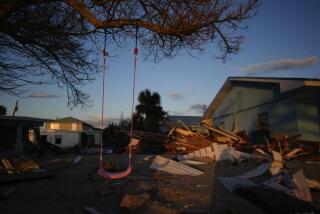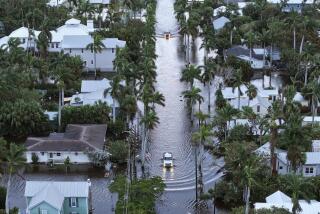Disaster, loss at every turn in wake of tornadoes
Reporting from Birmingham, Ala. — The scope of devastation left by the second-deadliest tornado blast in U.S. history continued to emerge Saturday as stunned survivors combed the wreckage of homes churned into matchsticks and aid workers and volunteers struggled to get food, water and generators to thousands displaced across seven Southern states.
Hundreds who spent the night in emergency shelters hastily erected in hardest-hit Tuscaloosa, Ala., scoured the remnants of their homes and businesses for photos and keepsakes, mostly in vain. Many returned dispiritedly to the shelters, where the first federal relief teams were handing out application forms for temporary housing and reconstruction aid.
The death toll across the South climbed to 345, according to state emergency services, exceeded only by a 1925 storm sweep that killed 747, the National Weather Service reported.
Photo gallery: Tornadoes cut path of devastation
Some of the displaced in towns throughout the region couldn’t make it back to their property to assess their losses because of security roadblocks and downed power lines. Kendra Coleman, her husband and three sons, were turned away as they tried to return to their three-bedroom apartment in Pratt City from the downtown Birmingham shelter where they had been sleeping since Wednesday.
At the shelter, Coleman said they were not permitted to shower and her boys were beginning to tire out.
“They tell me ‘Momma, I wanna go home,’ and I just want to cry,” she said. “Because I have no idea where home is anymore.”
The American Red Cross has opened 16 shelters across Alabama, taking in about 900 of the newly homeless, said spokesman Chris Osborne.
Eqecat, a disaster risk assessment operation, estimated the region sustained as much as $5 billion in insured losses alone from the tornadoes.
On Saturday, Tuscaloosa Mayor Walt Maddox said 39 people were confirmed dead in the area. Although 454 people were reported as missing to authorities, officials cautioned that many have likely been reunited with family or friends. About 30,000 people remained without power, but dozens of generators were being moved to the area to provide electricity to the shelters and makeshift dwellings cropping up to house those made homeless by the disaster.
About 1,000 National Guard troops and a mobile relief operations center were on their way from the Federal Emergency Management Agency, Maddox said.
The Obama administration continued its aggressive response to the disaster as five cabinet officials prepared to tour the damage and recovery efforts Sunday in the hardest-hit states of Alabama and Mississippi.
“Our top priority is to support the states and communities affected by this as recovery efforts are underway,” said Craig Fugate, administrator of the Federal Emergency Management Agency, who was already in the region.
FEMA said it has deployed incident management teams in five states struck by the deadly storms --Alabama, Georgia, Mississippi, Kentucky and Tennessee. The agency also has set up a support base in Maxwell, Ala., to help move water and other supplies to the affected areas.
The National Oceanic and Atmospheric Administration has sent survey teams to the region to assess and analyze the damage. And the Nuclear Regulatory Commission continues to monitor the situation at the Browns Ferry nuclear power facility near Athens, Ala., which lost off-site power Wednesday night because of the storms. The plant’s reactors were safely shut down using backup power.
The first memorials for some of the dead were planned Sunday for four University of Alabama students killed by Wednesday’s tornadoes, the university’s student newspaper, the Crimson White, reported. It also reported two other student deaths at Stillman College and Shelton State.
The wreckage inflicted by the storms prompted the university to end the spring semester early and send students home, said university spokeswoman Cathy Andreen. Students will have the option of forgoing final exams and keeping their current grades, and commencement has been postponed to August, she said.
Alabama absorbed the brunt of the weather’s violence, with 255 killed, the Alabama Emergency Management Agency reported. According to state emergency service officials across the South, there were 34 dead in Tennessee, 34 in Mississippi, 15 in Georgia, five in Virginia and one each in Arkansas and Kentucky.
The erratic blast of tornadoes took out whole towns, erasing their unique ways of life. In Hackleburg, Ala., two tornadoes killed 29 residents and wiped out 100 homes, three schools, the police and fire stations and the town’s biggest employer, the Wrangler clothing factory. Rainsville, near the Georgia and Tennessee borders, was without power but for a single generator brought in from Chattanooga by a local pharmacist. Much of Smithville, a town of 857 in northeast Mississippi, was smashed into kindling that blocked roads and hampered delivery of relief supplies.
The National Oceanic and Atmospheric Administration dispatched its infrared-sensing King Air 350CER surveillance plane to record the devastation between Tuscaloosa and Birmingham. The weather agency posted images of a central Tuscaloosa neighborhood from before and after the tornadoes revealing shocking ruin in the once-serene corner of the university town of 83,000. The agency put the number of tornadoes to strike the South last week at 288 in a three-day period.
Photo gallery: Tornadoes cut path of devastation
Esmeralda.bermudez@latimes.com
Williams reported from Los Angeles and Bermudez from Birmingham, Ala.
More to Read
Sign up for Essential California
The most important California stories and recommendations in your inbox every morning.
You may occasionally receive promotional content from the Los Angeles Times.












